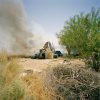Statement:
Images of children have pervaded all aspects of our society. By one estimate half of the 25 billion images made every year in the United States are of children. Most of these images are remarkably homogeneous. In fact, one family album looks remarkably like any other – it is very rare to find tears, tantrums, nightmares, etc. pictured within. They are almost exclusively stocked with photographs of happy children doing happy things – reinforcing our cultural ideal of childhood as a time of pure joy and innocence.
In the US alone, every day, thirteen children are killed by guns, nearly six children die from abuse, and eight thousand are neglected or abused. Others are plagued with the fear of abandonment, depression, neglect, loss, and rejection by peers.
My images serve to illustrate many of these physical and psychological terrors. By depicting the consequences of childhood abuse and trauma and the coping methods of survival, I hope to give the child a voice. In this series of images the past discordantly commingles with the present. I am trying to illustrate that children have always been forced to find a way to cope with the unbearable – and often they are able to find some sort of uneasy peace in spite of ruination.
Process notes: In this series, I am using imagery from throughout the history of photography to create the environments and the characters within. I therefore wanted to suggest the history of photography, and particularly the earliest viable photographic process, the daguerreotype. These images are printed onto aluminum, and the resultant image appears different as you move through the show. The images were photographed under very flat lighting, to most clearly show the image. To create these prints, silver salts were embedded into aluminum, placed in contact with an enlarged negative, exposed and developed. The aluminum plates were then anodized, trapping the salts within the metal and making it resistant to damage from chemicals, sunlight, or scratches. I feel that the durability of the metal references the resiliency of children in traumatic situations.




















